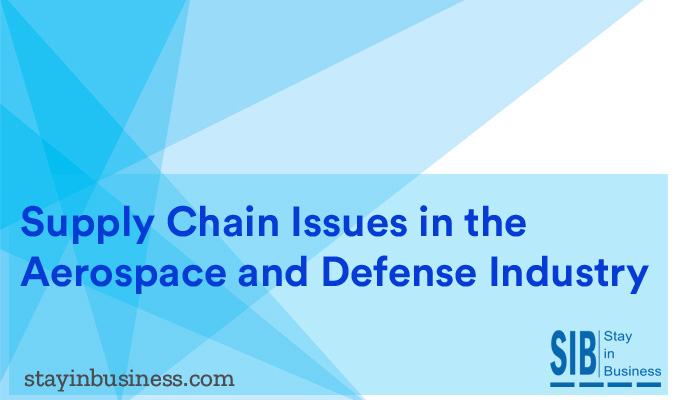
Supply Chain Issues in the Aerospace and Defense Industry
Business operations in the aerospace and defense sector has been expanding rapidly, registering nearly $700 billion in revenue in 2017. While these numbers don’t suggest an exceptional run, studies forecast a steady increase in earnings thanks to subsidized fuel rates and a growing market for air travel, especially in the Asia Pacific and Middle East. The time is ripe for the industry to prepare and capitalize on the prospective growth potential that just around the corner by addressing some fundamental supply chain issues.
Factors that can lead to business disruptions
Traveler needs are constantly changing. New innovations are transforming commercial operations. These technological breakthroughs include:
- Zero fuel flying
- Enhanced monitoring
- Plasma based technologies
- Use of graphene and carbon nanotubes
- Blockchain and automation
- 3D printing
While these advances have influenced major airliners in rethinking their operational strategies, the changes have introduced a number of factors into the supply chain that are disruptive to business. Major airplane manufacturing corporations are already behind schedule on their ongoing commitments. The production of thousands of aircrafts has yet to be completed and delivered. A major challenge for manufacturing companies today is to cater to the rise in demand. And a supply chain that is growing in complexity is the primary factor contributing to this situation.
Obtaining Primary Materials
Any airplane is composed of elements such as steel, manganese, titanium, nickel, copper and many more. An airline manufacturer would have to source these elements from suppliers who are spread all over the world. Production centers need to receive these components on time and with the prescribed quality levels.
Supply chain managers have to take various factors into consideration such as:
- From which locations can the best quality raw materials be obtained?
- How resilient the material is to wear and tear
- Does the price of the material fit the company’s budget?
- How will the material be shipped to the production center without damage or compromise to quality?
- Is the material delivery lead time compatible with the organization’s production demands?
Preventing Supply Chain Ruptures
Organizations are constantly trying to ensure accuracy in their forecasts for the future such as:
- The cost estimate of their assets
- Modification to product design
- Impact on commerce owing to sociopolitical changes
- Catastrophes such as natural disasters and global warming
There are two primary options to preventing supply chain issues. The first is by prioritizing urgent needs and seeing through the purchase of materials to meet monthly, quarterly, half yearly or yearly production demands. These can be effectuated as standalone transactions. The second option is to negotiate contractually binding lock-ins with tier 1 and tier 2 vendors for a tenure that lasts at least five to ten years.
A vendor’s core business focus is also an important factor to consider while nurturing long term alliances with strategic partners. Airline manufacturers should carefully assess the product portfolio of third party partners to gauge future needs and the supply of backup materials. Collaboration with third party business associates is essential while deciding on a strategy to tackle risks such as inflation, economic crisis, market downturns and so on.
Making Room for Technological Innovation
The aeronautics industry is a vibrant space for path breaking and pioneering trends such as automation and robotics. These innovations are often the cause for prolonged delays and commercial projects frequently miss the deadline because of this reason. There is always the risk of encountering hardware issues, wiring glitches or other hazards while deploying a new and improved application or software and these operational slowdowns always come hand in hand with monetary implications.
There have been instances where airline companies have spent billions of dollars working on a new technology over many years, even decades that negatively impacted performance such as engine start time, fuel efficiency and many more.
While innovation is a good thing, major corporations must plan out their strategic changes in phases in such a manner that they don’t fall behind on their ongoing obligations.
Lack of Personnel with Skills & Expertise
Rising demand has forced corporations to crank up the manufacturing rate in their production facilities. But the dearth of skilled manpower that can implement and use the new technologies and innovations is still a serious concern. The turnaround time for personnel training programs isn’t quick enough. And in many cases the modules don’t provide employees the necessary knowledge transfer to adequately handle complex workflows.
While innovation is here to stay, aircraft manufacturers must update the skills of their personnel across their supply chains in order to curb disruptions. Additive manufacturing, machine learning and Blockchain are some of the many trends that are gaining momentum in the aviation sector in a bid to evolve more robust systems, and corporations need skilled personnel with the expertise to work with these new solutions.
Conclusion
The aviation sector’s supply chain is a complex network that has a negligible margin for errors and consequently demands high levels of precision. Not surprisingly, the industry’s operational logistics is constantly exposed to threats and vulnerabilities which when exposed can lead to performance related issues even to the point of causing reputational damage. The business model of any airline company is inherently capital centric. And the high level of dependence on robust and resilient supply chains implies that business continuity and disaster recovery are all the more crucial for corporations to meet their production targets.
See for yourself how the application works
Witness our cloud based platform’s security capabilities in action
Play around with the software and explore its features
Compare and choose a solution that’s relevant to your organization
Consult our experts and decide on a pricing mechanism
Disasters
[carousel id=’1780′ items=’4′ items_desktop=’3′ margin_right=’5′ navigation=’false’] [item img_link=”https://www.stayinbusiness.com/wp-content/uploads/2016/02/Chemical-Spills-Discharges.jpg” href=”https://www.stayinbusiness.com/resource/disaster-recovery/chemical-spills-and-discharges/”][item img_link=”https://www.stayinbusiness.com/wp-content/uploads/2016/02/Riots-Public-Disturbances.jpg” href=”https://www.stayinbusiness.com/resource/disaster-recovery/riots-and-public-disturbances/”][item img_link=”https://www.stayinbusiness.com/wp-content/uploads/2016/02/Terrorism.jpg” href=”https://www.stayinbusiness.com/resource/disaster-recovery/terrorism/”] [item img_link=”https://www.stayinbusiness.com/wp-content/uploads/2016/02/worst-product-recall.jpg” href=”https://www.stayinbusiness.com/resource/disaster-recovery/product-recall/”] [/carousel]
